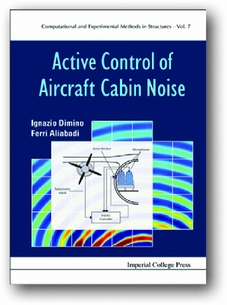
Modern airliners are more than 20 dB quieter than their predecessors, but this benefit is not always perceived by the passengers in the cabin. However, demand for improved cabin comfort, along with tightening legislation and awareness of the effects of human exposure to noise, is making interior noise an increasingly important commercial consideration.
Several methods for controlling radiation of noise into the cabin are being pursued, ranging from conventional soundproofing methods to more sophisticated techniques such as synchrophasing the propellers on turboprop aircraft. Sound absorbing materials are most effective at medium and high frequencies, but at low frequencies, effective noise reductions might only be achieved at the cost of unacceptable weight and volume increases. Tuned vibration absorbers are more successful at controlling low-frequency noise, but they work well at only a single frequency. By contrast, active or adaptive techniques, utilising actuators and control systems, can be applied to a wider range of frequencies, though at the cost of increased complexity.
This book aims to provide a bridge between control theory and the implementation of practical active noise control systems. It does this by considering the development of a laboratory-based demonstrator, a ‘smart window test bed’, laying out first the theoretical basis for the development of the system, then the practical design of the system, and finally reporting the experimental results and showing how these might be evaluated in terms of passenger comfort benefits.
The book is arranged in six chapters. Chapter 1 provides an introduction to cabin interior noise and outlines the place of active noise control among other control strategies.
The basic equations governing fluid-structure interactions as they relate to the cabin-noise problem are introduced in Chapter 2. The formulation of the coupled Finite Element Method for interior vibro-acoustic systems is also presented.
The fuselage of an aircraft, with acoustic treatment and trim panels, can be modelled as a multi-wall structure; a set of panels enclosed by fluid domains. Chapter 3 describes the principles of sound transmission through such multi-wall partitions. A numerical model for predicting the sound transmission loss is developed, and assessed by application to several test cases.
Chapter 4 presents an overview of the principles of active noise control and looks at some examples of practical applications. It then goes on to develop an adaptive feedforward control scheme, in which an input signal highly correlated with the disturbance is used to derive the control signal, and the magnitude and phase of the control inputs are adapted using feedback from error sensors. Multi-input/multi-output controllers are developed using three different control algorithms. Numerical simulations are then performed using varying numbers of actuators and sensors.
Chapter 6 describes an experimental demonstration of the active control system in the form of a ‘smart window’ on a laboratory test bed. A real-time control system is implemented using equipment and software that would be familiar to users of most university acoustic labs. It is pleasing that imperfections in the experimental set-up are acknowledged and discussed rather than ignored. Finally, the results are evaluated in terms of passenger comfort using a ‘virtual passenger model’ which considers the subjective human response to sound quality as well as objective parameters such as pressure level.
There are three appendices. The first two present numerical studies of structures with surface-bonded piezoelectric actuators and sound power radiation from baffled rectangular plates. The third describes some preliminary experimental studies of the actuators used in the main experiment. A comprehensive bibliography and index are also provided.
The text is well written and supported by clear and useful illustrations. This would be a useful textbook for postgraduate or advanced undergraduate studies and would also make a good introductory text for engineers moving into the field. The literature survey and bibliography provide a useful starting point for further study.


